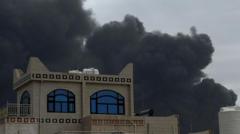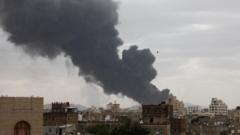The U.S. military has been actively conducting operations in Yemen against Houthi militia members since March 15, but they have withheld key details about these strikes, raising questions about transparency and strategic considerations.
U.S. Military Remains Tight-lipped on Ongoing Strikes in Yemen

U.S. Military Remains Tight-lipped on Ongoing Strikes in Yemen
The Pentagon is under scrutiny as it limits information on recent military operations against Houthi targets.
The article text:
The U.S. military has been carrying out daily airstrikes targeting Houthi militia positions in Yemen since March 15, yet the Pentagon has provided minimal information regarding these operations. The last major update came on March 17, when military officials announced over 30 successful strikes against Houthi assets on the campaign's inaugural day. Despite ongoing actions, the military has not disclosed the total number of strikes or the identification of Houthi commanders reportedly killed.
Visuals shared by the Central Command on social media show military jets engaged in missions against the Iranian-backed faction; however, specifics surrounding the operational success have remained undisclosed.
These military strikes are set against a backdrop of controversy involving Defense Secretary Pete Hegseth and other notable members of the Trump administration, who, in a group chat prior to the mission, shared sensitive details that may have inadvertently compromised American pilots' safety.
On Monday, Jeffrey Goldberg, the editor in chief of The Atlantic, revealed he was unintentionally added to this messaging chat, emphasizing the potential risks stemming from such communication lapses. In response to the situation, Hegseth attempted to downplay the gravity of the breach, stating, “Nobody was texting war plans, and that’s all I have to say about that.”
A spokesman for Central Command provided a brief overview this week, claiming that the operations had resulted in the destruction of essential Houthi military infrastructure, including command and control facilities, air defense systems, weapons manufacturing sites, and storage for advanced weaponry. However, without further clarity and information on the strikes, concerns about operational security and strategy remain prevalent among observers and military analysts.
The U.S. military has been carrying out daily airstrikes targeting Houthi militia positions in Yemen since March 15, yet the Pentagon has provided minimal information regarding these operations. The last major update came on March 17, when military officials announced over 30 successful strikes against Houthi assets on the campaign's inaugural day. Despite ongoing actions, the military has not disclosed the total number of strikes or the identification of Houthi commanders reportedly killed.
Visuals shared by the Central Command on social media show military jets engaged in missions against the Iranian-backed faction; however, specifics surrounding the operational success have remained undisclosed.
These military strikes are set against a backdrop of controversy involving Defense Secretary Pete Hegseth and other notable members of the Trump administration, who, in a group chat prior to the mission, shared sensitive details that may have inadvertently compromised American pilots' safety.
On Monday, Jeffrey Goldberg, the editor in chief of The Atlantic, revealed he was unintentionally added to this messaging chat, emphasizing the potential risks stemming from such communication lapses. In response to the situation, Hegseth attempted to downplay the gravity of the breach, stating, “Nobody was texting war plans, and that’s all I have to say about that.”
A spokesman for Central Command provided a brief overview this week, claiming that the operations had resulted in the destruction of essential Houthi military infrastructure, including command and control facilities, air defense systems, weapons manufacturing sites, and storage for advanced weaponry. However, without further clarity and information on the strikes, concerns about operational security and strategy remain prevalent among observers and military analysts.






















